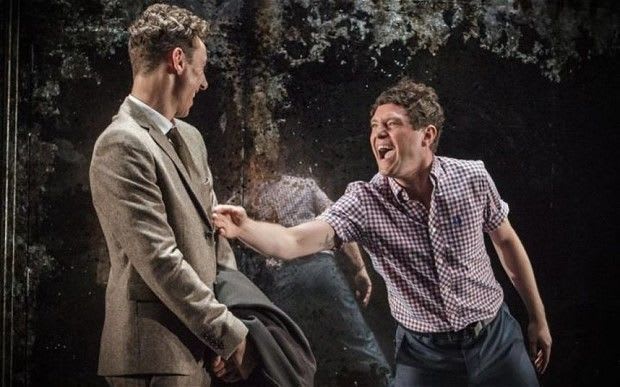If speed and frequency of revivals counts for anything, then the status of Alexi Kaye Campbell’s The Pride as a contemporary classic seems assured. In the mere five years since its Royal Court debut, Campbell’s play has been produced at Sheffield and received two starry New York productions.
And, now, already, it’s back in a major West End revival, as the latest high-profile offering in Jamie Lloyd’s Trafalgar Transformed season, in a production that, while consistently lively and sometimes moving, doesn’t quite disguise some flaws in the drama’s design or its ultimately retrogressive perspective.
Essentially Campbell offers two plays for the price of one in The Pride, setting up an interwoven dual timeline that juxtaposes 1950s repression with naughty-noughties libertine-ness in order to explore issues of fulfilment in, and changing attitudes towards, homosexual relationships.
The focus is on a trio of characters. In 1958, Philip is a property-agent introduced by his wife Sylvia to Oliver, a well-travelled children’s author’s whose latest book she is illustrating. A sense of recognition and attraction sparks between the two men, but any chance of a more lasting relationship founders on Philip’s brutal denial of his sexuality.
In 2008, it’s Oliver and Philip who are the couple, but now their union is seriously threatened by something else: Oliver’s addiction to cruising and Internet hook-ups. Unfolding in the week leading up to London’s Gay Pride, this contemporary strands finds Oliver consulting Sylvia (here his supportive, if increasingly impatient, pal) about his predicament as he struggles to adjust to life without Philip.
There’s a significant precedent for The Pride’s structure: Mark Ravenhill’s 2001 play Mother Clap’s Molly House, which zipped between eighteenth and early twenty-first century London in order to contrast two versions of hedonistic gay male experience. Campbell similarly locates an emotional vacuum at the heart of our anything-goes culture, but if Ravenhill’s interest was in the economics underpinning “illicit” sexuality then Campbell’s concern lies more with the consequences both of repression and of liberation, the challenges and responsibilities involved in each.
The play’s contention is that 1958 Oliver and 2008 Oliver are equally screwed up by the societal expectations they’ve imbibed and that the former’s denial of his sexual desires and the latter’s embracing of his result, equally, in damaging betrayals of self.
That’s all well and good—if a tad too symmetrical—up to a point. But the fifties scenes that Campbell has fashioned are so much richer and more involving than the 2008 scenes that the play feels fatally unbalanced. Certainly The Pride falls back upon a cliché-veering image of 1950s middle-class England that contemporary audiences can easily endorse: it’s all cut-glass vowels and quivering by the cocktail cabinet, a place where gay men end up fearful and depressed at best and suicidal or gruesomely "medicalised" at worst. But these scenes transcend their sub-Rattigan inclinations and generate an immersive power, culminating in a devastating final encounter between Philip and Oliver.
The quip-strewn 2008 scenes feel crude and obvious by comparison, pivoting around a will-boy-get-boy-back? premise that wouldn’t disgrace your average Hollywood rom com. Oliver’s sexual exploits are played for prurience or easy laughs, but what’s hard to swallow (no pun intended) is the play’s endorsing of coupledom (Campbell’s careful code-word is “intimacy”) as the desirable goal for homosexuals.
Thus, for all the frank sex talk, an uncomfortably reactionary perspective starts to emerge. Though much less po-faced in tone than Steve McQueen’s sex addiction melodrama Shame, The Pride ultimately falls victim to a similar moralising tendency, in which Oliver’s promiscuity is presented as an adolescent addiction to be fought against just as his ties to mummy-figure Sylvia must be, somewhat, cut.
Returning to the play that he first directed at the Royal Court in 2008, Jamie Lloyd’s slick staging doesn’t hide—and at times accentuates—some of these problematic aspects. But it does boast good performances that find the right emotional beats, especially in the more compelling 1950s scenes.
Al Weaver brings a beautiful intensity and earnestness, with lovely undercurrents of playfulness, to his role as his 1958 Oliver and conveys the contemporary version’s neediness and horniness with aplomb.
He’s partnered well by Harry Hadden-Paton (here effectively channelling the Rattigan chops he’s already proved via his memorable turns in Flare Path and Terence Davies’s film of The Deep Blue Sea); it’s a pity that Hadden-Paton is left with so little to do in the 2008 strand.
Hayley Atwell also struggles a tad with her rather rigged contemporary role but shows the 1958 Sylvia’s loneliness and perceptiveness with economical insight.
And Mathew Horne multitasks quite effectively across the trio of significant supporting roles, playing to the gallery as a rent boy and a lad’s mag editor and finally contributing a quietly sinister turn as a 1950s medic administering aversion-therapy.
Judging by the ecstatic audience response, Lloyd’s revival of The Pride looks likely to be a big success. If the production proves something of a mixed bag ultimately, then that’s due to the fact that Campbell has written only half a really good play here, one in which—dramatically speaking—it’s the wounds wrought by repression, rather than the challenges of liberation, that resonate the most.
